The DVD format is a successor to the CD, and also creates new market opportunities for digital optical disc technology. DVD improves on the CD in all respects and in particular provides larger storage capacity and faster reading and writing. The technological improvement provided by the DVD specification allows filmmakers, musicians, and programmers to expand their creative horizons beyond old data carriers, and lets users enjoy the result. For everyone, DVD provides greatly upgraded capacity and flexibility of data storage. In particular, compared to previous consumer video formats, the DVD provides a significant improvement in the video and sound quality of the playback of motion pictures.
Development and Overview
Beginning with the CD-Audio format, and the subsequent development of CD-ROM, CD-R, and CD-RW, the CD revolutionized data storage. However, the CD's limited capacity and slow throughput bit rate made it unsuitable for high bandwidth or large volume applications such as high quality digital video. Thus, the motion picture industry sought to develop a small optical disc holding a feature film coded with high-quality digital video. In December 1994, Sony and Philips proposed the MultiMedia Compact Disc (MMCD). In January 1995, Toshiba and Time Warner proposed the Super Density disc (SD). The DVD Technical Working Group subsequently outlined these criteria for the new video disc: A single standard that was fully interchangeable for TV and PC applications; fully backward-compatible with existing CD media, forward compatible with write-once and rewritable media; low-cost and high-quality disc replication; a single universal file structure; support for both linear and nonlinear applications; and high capacity that was expandable for high definition media.
The SD and MMCD formats were similar but incompatible, and computer industry representatives urged the two sides to produce a unified standard. Subsequently, the SD and MMCD formats were merged. Moreover, the scope of the video-centric format was expanded to include digital audio and both playback-only and recordable media for general computer applications. The DVD family of formats was thus developed by a consortium of manufacturers known as the DVD Forum. Several working groups were charged with the development of different formats and aspects within the family. The preliminary DVD format was announced in December 1995. The DVD family includes different formats for video, audio, and computer applications. Because the scope of the applications far exceeded digital video, the original name of Digital Video Disc was changed to Digital Versatile Disc, but that name was never fully accepted. Instead, the format is simply called DVD.
Whatever the jargon, DVD supersedes the CD in the music and computer software markets and supersedes the Laserdisc and VHS tape in the video market. The DVD Video and DVD-ROM formats were the first of the family to be introduced, early in 1997. Approximately 5 million DVD ROM drives and 1.2 million DVD-Video players were sold in 1998. At the end of 1998, about 2000 DVD-Video titles were available. By mid-2004, over 34,000 DVD titles were in release, and since launch, more than 103 million DVD players had been sold and over 3 billion discs had been shipped. These early growth rates surpassed those of any other existing entertainment medium. DVD is also credited as a key factor behind the migration to digital television.
The DVD family portrait is shown in FIG. 1. There are six DVD books: Book A is DVD-ROM (Read-Only Memory); Book B is DVD-Video; Book C is DVD-Audio; Book D is DVD-R (Recordable); Book E is DVD-RAM (Random-Access Memory); and Book F is DVD-RW (ReWritable). The specification is further classified in several parts. Part 1 defines the physical specifications, Part 2 defines the file system specifications, and subsequent parts define specific applications and extensions. For example, Part 3 defines the Video application, Part 4 defines the Audio application, and Part 5 defines the Video Audio Navigation (VAN) extension.
DVD-ROM, DVD-Video, and DVD-Audio discs (all read only in nature) share the same disc specifications and physical format. Likewise they all share the same file system. The DVD-R, DVD-RAM, and DVD-RW formats are more unique. The DVD specification borrows from other existing specifications. For example, the DVD file system uses elements of the UDF, ISO 9660, and ISO 13346 specifications. DVD-Video generally uses MPEG video coding and Dolby Digital (AC-3) or DTS audio coding, and DVD-Audio generally uses PCM and MLP (Meridian Lossless Packing) coding, as well as Dolby Digital.
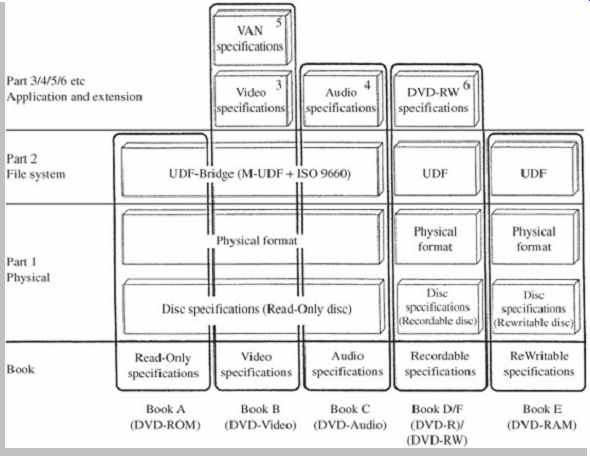
FIG. 1 The DVD family of specifications includes six books for read-only
and recordable discs. Some physical and file system attributes are shared,
but specific application details are distinct to each specification book.
Although based on CD technology, DVD employs new physical specifications and a new file format.
Philosophically, DVD differs considerably from the CD.
Whereas the CD was originally designed exclusively as an audio storage format, and incrementally adapted to other applications, DVD was wholly designed as a universal storage platform. The CD is also a simple format, designed to work with or without microprocessors in the player. In contrast, DVD is based on sophisticated microprocessor control to read its file structure and interact with the disc and its contents. Perhaps most importantly, Red Book CD-Audio was designed to play back a continuous stream of data thus addressing was not needed. Yellow Book CD ROM only subsequently added addressing capability. In contrast, DVD is founded on the premise that all data will be addressable and randomly accessible. In short, all DVD contents are essentially viewed as software data. In that respect, DVD is more akin to CD-ROM than CD-Audio.
In all respects, DVD surpasses the CD format. Perhaps most strikingly, although its outer physical dimensions are identical, one DVD data layer provides seven times the storage capacity of CD. This increase is due to the shorter wavelength laser, higher numerical aperture, smaller track pitch, and other aspects, as illustrated in FIG. 2. In addition, overall disc and player tolerances are more stringent compared to those stipulated for the CD; this takes into account the improvement in manufacturing precision gained over the intervening 15 years. In all, the recording density of CD is 1 bit/mm2 whereas the DVD recording density is 6 to 7 bits/mm2. Even so, time marches on. The specifications of the DVD format have been eclipsed by the Blu-ray format.
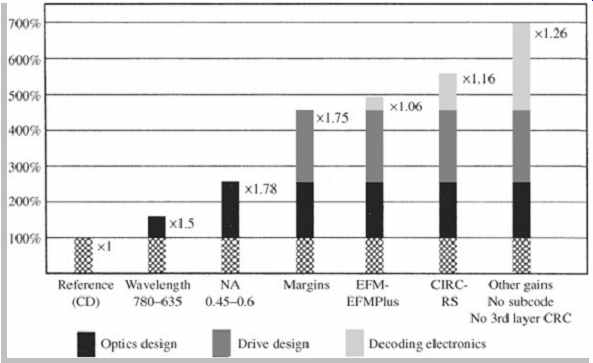
FIG. 2 A DVD disc layer holds seven times the data capacity of CD. This
is accomplished through improvements in optics design, improved drive design
and precision, and more sophisticated decoding electronics. (Schouhamer Immink,
1996)
Disc Design
Part 1 of the DVD specification defines the physical specifications of DVD discs. The specifications for the DVD-ROM, DVD-Video, and DVD-Audio discs are identical; thus, Part 1 applies to all three formats. These read-only formats thus share disc construction, modulation code, error correction, and so on. The physical parameters call for 120-mm-and 80-mm-diameter discs, and single and dual layers per substrate. As with CD, DVD discs use a pit/land structure to store data. The DVD track pitch is 0.74 mm. The constant linear velocity (CLV) track velocity is 3.49 m/s on a single layer and 3.84 m/s on a dual layer. The pits and land that store binary data are as short as 0.4 mm.
Minimum/maximum pit length is 0.40/1.87 mm (single layer) and 0.44/2.05 mm (dual layer).
These small dimensions are possible because the laser beam used to read DVD discs uses a visible red wavelength of 635 nm or 650 nm (both wavelengths are supported) compared to 780 nm in a CD. The standard specifies a lens with a numerical aperture (NA) of 0.6, compared to a CD's NA of 0.45. Together, the shorter laser wavelength and higher NA allow smaller pit dimensions which in turn allow a data density increase of 467% over that of CD. A DVD data layer holds about four times as many pits as a CD layer as shown in FIG. 3. If unwound, a DVD track would run for almost 7.5 miles. Combined with other coding efficiencies, a DVD layer can store 4.7 Gbytes of data and multiple data layers provide greater capacity. It is worth noting that the quoted DVD capacity of 4.7 Gbytes is more precisely 4.7 billion bytes (measured in multiples of 1000); in computer terms (measured in multiples of 1024) the capacity is 4.38 Gbytes.
Disc Optical Specification
A DVD disc appears similar to a CD and is the same diameter (120 mm) and thickness (1.2 mm). Whereas a CD uses a single polycarbonate substrate, a DVD disc employs two 0.6-mm substrates bonded together with the data layers placed near the internal interface. All data is held in a spiral data track that is read with counterclockwise rotation. The layer closest to the readout surface is Layer 0, and the layer further from the readout surface is Layer 1.
Layer 0 is read first. A reading laser starts at the innermost radius of Layer 0 and reads to the disc outer edge, where it reaches a middle area, stops and refocuses, and reads Layer 1 from the outer edge to the inner radius; this is called opposite track path (OTP) organization. Alternatively, Layer 1 can be independently written from an inner to outer radius; this is called parallel track path (PTP). In PTP, each layer requires its own lead-in and lead-out areas.
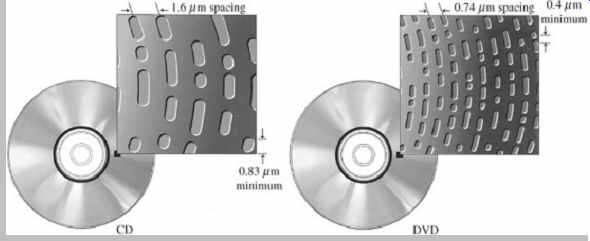
FIG. 3 A comparison of CD and DVD data surfaces shows that a DVD holds
about four times as many pits as a CD. With other improved efficiencies, overall
capacity of a DVD is increased seven times.
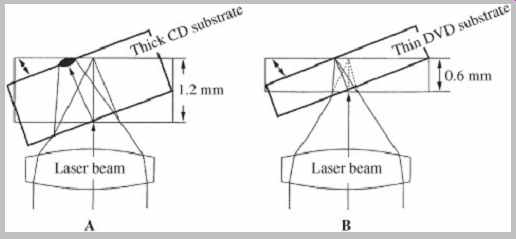
FIG. 4 The thin (0.6-mm) DVD substrate is less sensitive to tracking and
detection errors due to disc tilt. A. Thick CD substrate allows greater deviation.
B. Thin DVD substrate has less deviation.
Whereas a CD data layer is near the disc's top surface and thus somewhat vulnerable to damage, DVD data layers are embedded deeply within the disc and thus are more protected. Thinner substrates are advantageous because they are inherently more resistant to tracking errors that result when a disc is slightly tilted relative to the laser pickup, as shown in FIG. 4. However, because the thin substrate places the data layer closer to the outer disc surface, surface contamination is not placed as far out of focus as with a CD; this is compensated for with more powerful error correction. The DVD finished disc specification for radial tilt is ±0.8°, and for refractive index is 1.55 ± 0.10. A summary of specifications for CD and DVD is given in Table 1.
The dual substrate construction allows manufacturing variants, yielding five different capacities of playback-only discs. They are known as DVD-5, DVD-9, DVD-10, DVD 14, and DVD-18. As the nomenclature loosely suggests, the disc capacities are: 4.7, 8.54, 9.4, 13.24, and 17.08 billions of bytes, respectively. Expressed in terms of 8-bit bytes, they hold 4.37, 7.95, 8.75, 12.33, and 15.91 Gbytes.
This is roughly a 7.4% difference (1 billion is 1,000,000,000 or 109, and 1 Gbyte is 1,073,741,824 or 230). When the average data output bit rate is 4.8 Mbps, the approximate playing times are: 133, 241, 266, 375, and 482 minutes, respectively. Of course, the bit rate can vary widely, and thus playing times vary too. For example, a DVD-5 disc can hold from 1 to 9 hours of video. Generally, a DVD-Video disc that holds a 2-hour movie and modest bonus features is a DVD-9 disc.
A single-layer, single-sided DVD-5 disc uses one substrate with a data surface and one blank substrate. The substrates are bonded together with either a hot-melt glue or an ultraviolet-cured photopolymer (2P); the former is generally preferred. Two substrates with data surfaces can be bonded together to form a single-layer, double-sided DVD-10 disc; the disc is turned over to access the opposite layer. The DVD standard also allows data to be placed on two layers in a substrate, one embedded beneath the other to create a dual-layer disc that is read from one side; this comprises a DVD-9 disc. Two dual layer substrates comprise a double-sided DVD-18 disc.
The layers are separated by a clear resin and a very thin semi-reflective (from 25 to 40%) layer of gold or silicon; this layer is sometimes referred to as a semi-transparent layer.
Gold is sputtered with conventional metallization techniques. Silicon is similarly sputtered, using argon gas.
Clearly, gold is more expensive than silicon. The environmental stability and playability performance of the silicon semi-reflective layer meets or exceeds that of gold based discs. When a layer is read through a bonding layer, the bonding material must be transparent; a 2P bonding agent can be used.
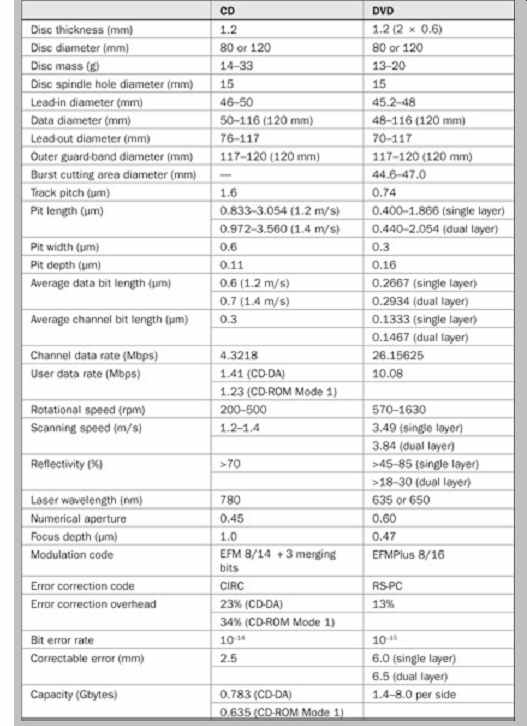
Table 1 Comparison of CD and DVD disc and player specifications.
When using a semi-reflective and fully reflective layer, both layers can be read from one disc side by simply focusing the reading laser on either layer. The beam either reflects from the lower semi-reflective layer or passes through it and reflects from the top fully reflective layer. The laser light can be switched to either data layer in a few milliseconds (they are about 40 mm to 70 mm apart) by simply moving the objective lens; a buffer memory makes the transition indiscernible. Because reflectivity of the embedded layer is reduced, as is the signal-to-noise ratio (because of out-of-focus imaging from the inner layer), for reliable playback the embedded layer is formed with a faster linear velocity and thus holds somewhat less data than the top data layer. The interior data surface uses a faster scanning velocity of 3.84 m/s versus 3.49 m/s, thus the pit length is longer; for example, the minimum pit length is 0.44 mm versus 0.4 mm.
Conventional DVD discs cannot be played in CD players. However, the DVD-Forum devised specifications for a hybrid CD/DVD-Audio disc that plays in CD and DVD-Audio capable players. The DualDisc format comprises a double-sided disc that allows DVD-Audio data (multichannel audio or video) to be read from one side, and CD data (stereo music) from the other. For example, a movie could be accompanied by its (CD) soundtrack, or DVD bonus features could accompany a CD album. DualDiscs are slightly thicker (perhaps 1.4 mm to 1.5 mm) than the 1.2-mm nominal thickness of CD and DVD discs, but are playable in most DVD-Audio and CD players.
Disc Manufacturing and Playback
DVD manufacturing is very similar to CD manufacturing, as described in Section 7, but tighter tolerances and some new manufacturing steps are needed. Following authoring, disc content is typically imaged on a hard-disk drive, and then transferred to another delivery medium. In many cases, the content image is delivered to the disc mastering facility on Digital Linear Tape (DLT) using ANSI format. A DLT Type III tape cartridge can hold up to 10 Gbytes of uncompressed data; DLT Type IV tapes are also widely used and can hold up to 80 Gbytes of uncompressed data.
With a transfer rate of 1.25 Mbytes/sec, a 135-minute program can be transferred in about an hour. A separate DLT is used for each physical disc layer and copy protection such as Content Scrambling System (CSS) and Content Protection for Prerecorded Media (CPPM) can be enabled. Alternatively, other authoring media such as DVD R or DVD + R (single or dual layer) using the Cutting Master Format or Exabyte tape are sometimes used for simpler projects. In some cases, electronic file delivery via private secure networks is used to move files from authoring studios to replication plants. Content that will be copy protected cannot be submitted on CD-R.
Disc Description Protocol (DDP) files may accompany the master; this data provides the laser beam recorder (LBR) with disc identification information. Other data files (such as DVDID/DDPID and CONTROL.DAT) also accompany the content image file, supplying disc type, copy protection, and other information. DVD-Video and DVD-Audio authoring systems often use the Joliet extensions (supporting longer file names) in the ISO 9660 file format (within UDF Bridge); this assists compatibility in legacy operating systems that are unable to read UDF Bridge. Authoring systems must also read Macintosh file formats to allow conversion to the UDF Bridge format.
In DVD mastering, shorter wavelengths must be used in the laser beam recorder to create the smaller formations; blue, ultraviolet, or violet krypton lasers may be used. In some cases, solid-state lasers (instead of gas lasers) with frequency-doubling crystals are used. Either photoresist mastering or direct dye-polymer mastering may be used.
All DVD discs use two substrates. Even in single-sided discs, two substrates, one holding data and the other a dummy substrate (with a cosmetic metal layer) must be manufactured. The thin DVD substrates require greater care in the molding process. For example, it is more difficult to uniformly flow molten polycarbonate into a thinner mold with minimal stress. The finer pit structure and the geometry of the pits (shorter and narrower than CD pits resulting in a steeper height-to-width ratio) may require injection molding machines with higher tonnage. Finally, it is more difficult to separate the disc from the stamper mold without strain.
In the case of double-sided discs, two substrates are independently formed, and then bonded together using a hot-melt adhesive or UV-curable bonding agent (the latter is preferred). As noted, dual-layer discs can be manufactured by independently molding two 0.6-mm polycarbonate substrates with one layer receiving full metallization and the other receiving semi-reflective metallization. The two substrates are then bonded together with a layer of UV-cured optically clear photopolymer as shown in FIG. 5. The reading laser can focus through the semi-reflective layer (and the bonding material with a thickness of about 55 mm) to read the upper substrate; this design can be used to manufacture single-sided discs (such as some DVD-9 discs).
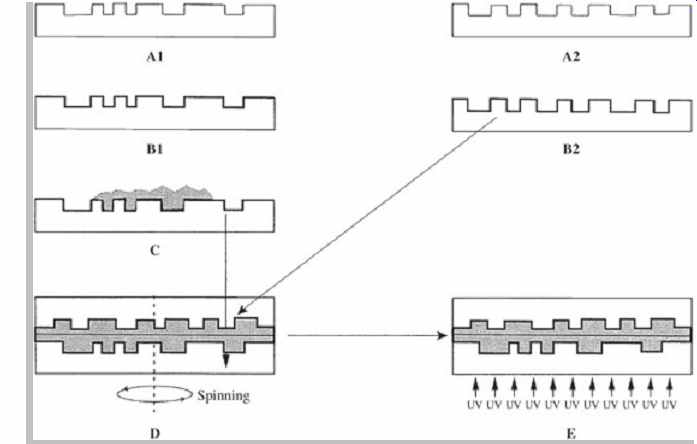
FIG. 5 Single-sided, dual-layer DVD-9 discs can be manufactured with data
layers on two substrates, one with a semi-reflective surface and another with
a fully reflective surface. The replication steps are shown. A1. Replicate
first-layer substrate. A2. Replicate second-layer substrate. B1. Deposit semi-reflective
layer. B2. Deposit fully reflective layer. C. Put UV-hardened bonding resin
on substrate. D. Bond substrates. E. Harden with UV light.
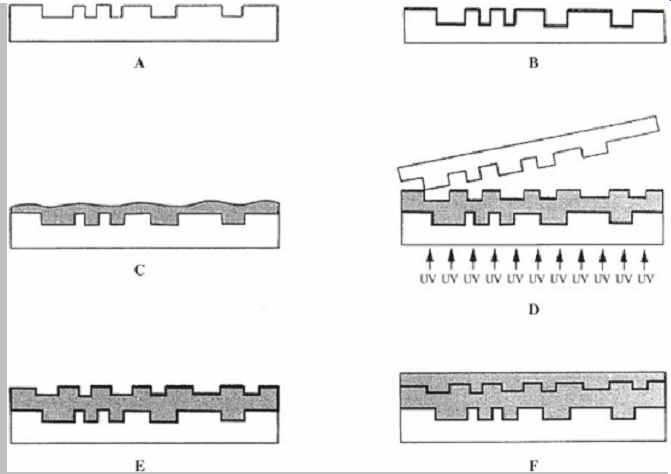

FIG. 6 Dual-layer substrates can be manufactured by pressing a second
data layer into an intermediate resin layer. This technique can be used to
produce substrates for single-sided, dual-layer (DVD-9) discs and double-sided,
dual-layer (DVD-18) discs. The replication steps are shown. A. Replicate first
layer substrate. B. Deposit semi reflective layer. C. Put UV-hardened resin
on substrate. D. Replicate pits of second layer on resin by stamper. E. Deposit
fully reflective layer. F. Apply UV-hardened resin to form protective layer.
Alternatively, a molded single-layer substrate can be coated with a semi-reflective layer followed by a layer of liquid photopolymer that is molded by a second stamper and hardened by exposure to ultraviolet light; after the layer is hardened, the stamper is removed and a fully reflective metal layer is applied and the substrate is ready for bonding to a second substrate, as shown in FIG. 6. This technique is used for some DVD-9 and DVD-18 discs. In another approach, the first information layer is molded on an interim 0.6-mm polymethyl methacrylate (PMMA) substrate, and it is sputtered with aluminum. The PMMA substrate (which shares no strong molecular bonds with aluminum) is peeled away and recycled, leaving the resultant aluminum information layer that is transferred onto a basic gold metal/polycarbonate DVD substrate with an adhesive. The six disc types are shown in FIG. 7.
Optical Playback
Although backward compatibility with CD is not required (but is recommended) by the DVD specification, in practice all DVD players can read CD discs with molded plastic pits. To accomplish this, the laser must be able to focus on CD data layers at about 1.2 mm from the readout surface, as well as DVD layers at about 0.6 mm from the surface.
Some pickups use a single shared objective lens for the CD and DVD wavelengths. The pickup has both 780-nm and 635/650-nm laser diodes, and a largely shared light path. In some designs, as shown in FIG. 8, holographic pickups use an aspherical lens; annular rings are cut into the center of the lens so that light passing through it is diffracted, yielding a longer focal length. Light passing through the outer smooth part of the lens has a shorter focal length. The optical spots appear to the photodiode array as concentric circles; light reflecting from 1.2 mm forms an inner circle and light reflecting from 0.6 mm forms an outer circle. Alternatively, a dual pickup can be designed with independent sections for each wavelength source including two separate objective lenses-one for CD and another for DVD.
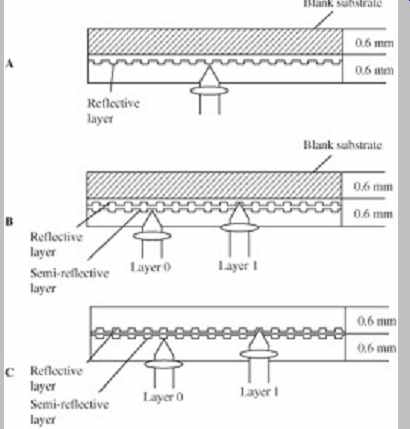
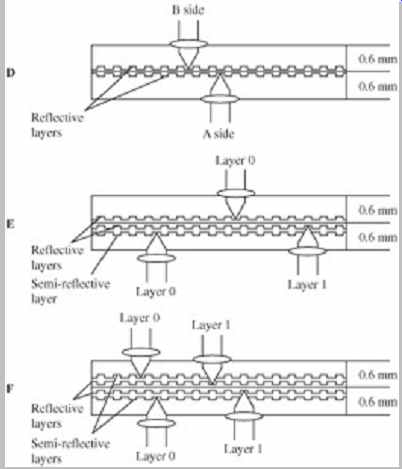
FIG. 7 The DVD specification allows multiple disc types. A. Single-sided,
single-layer DVD-5. B. Single sided, dual-layer DVD-9. C. Single-sided, dual-layer
(alternate version) DVD-9. D. Double-sided, single-layer DVD-10. E. Double-sided,
single-/dual-layer DVD-14. F. Double-sided, dual-layer DVD-18.
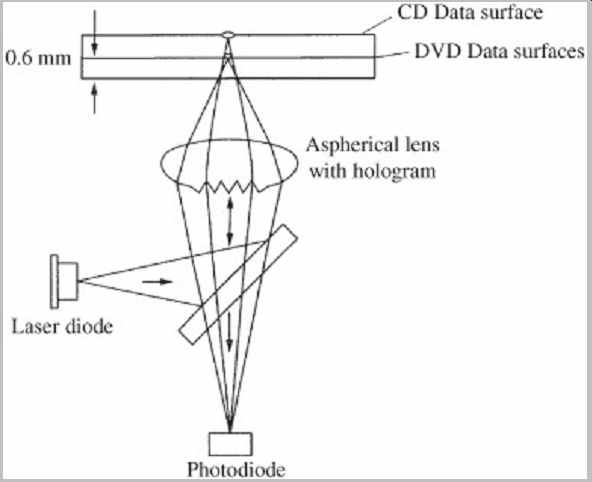
FIG. 8 A DVD pickup can be designed to focus on either CD or DVD data
layers. Different focal lengths can be achieved with a variety of techniques
including a holographic lens.
Playback of CD-R discs is problematic; the optical response of the organic dye recording layer is extremely wavelength-dependent, with high absorption below a narrow range of around 780 nm. For example, a CD-R disc may have 65% reflectivity at 780 nm and only 10% reflectivity at 650 nm. As a result, contrast is low and the disc is difficult to read at 635 nm or 650 nm. CD-R compatible DVD pickups are designed with two discrete optical paths at two wavelengths, or may employ one objective lens with two lasers. In one design, the numerical aperture is adjusted by coating the lens' outer circumference with a material that is opaque at 780 nm but transparent at 635 nm and 650 nm. When a 780-nm laser is used, the coating restricts the NA to 0.45, but when a 635-nm or 650-nm laser is used, since the coating is transparent, the NA is increased to 0.6 for reading DVD discs. Alternatively, for example, a dual-laser pickup could mount two objective lenses on a rotating head that places the appropriate lens in the optical path.
Many DVD drives use a differential phase-detection (DPD) method for autotracking. The pickup monitors asymmetry in the intensity pattern of the diffraction from the edges of pits. In particular, as an off-center spot moves from the leading edge to the trailing edge of a pit, the intensity of the pattern rotates. The pattern illuminates a four-quadrant photodiode, as shown in FIG. 9. In this example, at the leading edge of the pit, diode pairs B + D receive less light than pairs A + C; when the spot is in the middle of the pit, the diode pairs receive equal intensity; at the trailing edge, B + D receive more light than A + C. This is used to generate a tracking error signal.
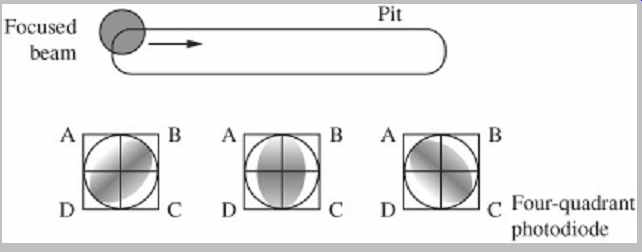
FIG. 9 In the DPD autotracking method, an off-center beam creates a rotation
in the intensity of the reflected beam as a pit is scanned. This is sensed
by a four quadrant photodiode. In this figure, darkened areas in the photodiode
represent lower light intensity. (Carriere et al., 2000)
Data Coding
The disc lead-in area is the innermost area of the Information Area. It consists of the Initial zone, Reference code zone, Buffer zone 1, Control data zone, and Buffer zone 2. A Control data block comprises 16 sectors; information includes disc size, minimum readout rate, single/dual layer, track path, disc manufacturing information, and copyright. A Burst Cutting Area (BCA) is located inside the lead-in area, between 44.6 mm and 47 mm from center. BCA can create a unique serial number or ID code comprising a series of low-reflectance stripes, similar to a bar code, extending along the radial direction. It holds up to 188 bytes, in 16-byte increments. The code can be recorded by a high-power YAG laser that melts the aluminum sputtering layer to create the lines; codes can be written in both single and dual layers. The code is read by a drive's optical pickup. Recordable DVD media use the BCA to uniquely identify each disc; this can be used to encrypt recorded data for copy-protection purposes.
The read-only DVD data structure is similar to that of a CD-ROM in which data is stored in files within directories; this increases data density. DVD data is placed on a disc in physical sectors that run continuously without a gap from the lead-in to the lead-out areas. The lead-in area ends at address 02FFFF and data begins at address 030000. Two types of dual-layer discs are defined: parallel track and opposite track. In a parallel track path disc, addresses of both layers ascend from the inner radius, and there are two lead-in and lead-out areas. In an opposite track path disc, Layer 1 addresses ascend as the laser moves toward the inner radius, and there is one lead-in and lead-out area, and two middle areas. In a DVD disc, the lead-in area starts 2 mm closer to the center than on a CD.
A data sector comprises 2064 bytes, called Data Unit 1.
It consists of 2048 bytes of main user data and 16 bytes of header; the latter comprises four bytes of sector identification (ID), two bytes of ID error detection (IED), six bytes reserved for copyright management, and four bytes of error detection code (EDC) data. A data sector can be viewed as a block of 2064 bytes with 172 bytes in 12 lines, as shown in FIG. 10. The four bytes of ID contain one byte of sector information and three bytes of sector number. A synchronization code is added to the head of every 91 bytes in the recording sector; this forms a physical sector; in all, 52 bytes of synchronization code are added. The initial 2048 bytes of user data is thus increased to 2418 bytes (2048 user + 16 header + 302 error correction + 52 synchronization).
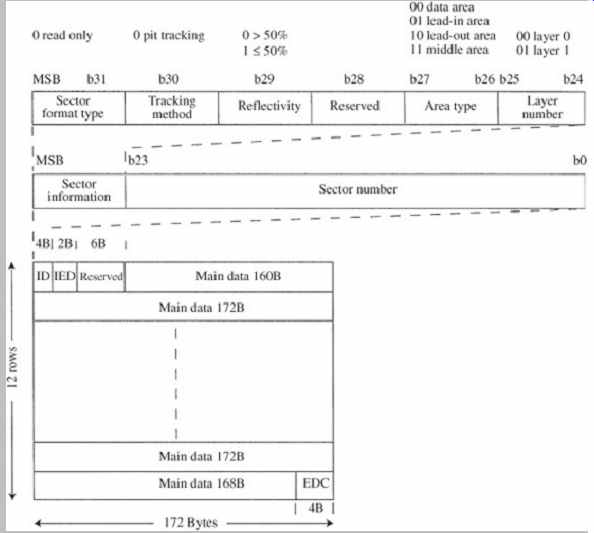
FIG. 10 DVD data is placed in sectors, each with 2064 bytes of data. Four
bytes of ID data contain sector information.
Reed-Solomon Product Code
The DVD format employs a Reed-Solomon Product Code (RS-PC) for error correction. This code uses a combination of two Reed-Solomon codes (denoted by C1 and C2) as a product code. It differs from the CD's CIRC code and is more similar to the code used in the DAT format. In the CD format, CD-ROM data can be coded with additional error correction; in the DVD format, all disc types use the same level of error correction. Moreover, in DVD, error concealment is not used. Instead, the data reliability of all DVD data must approach computer standards. The CIRC code uses a convolutional structure that is suited to long streams of data. In contrast, the matrix structure of the RS PC code is suited to small blocks of data. It is a product code in which rows of outer parity are crossed with columns of inner parity. A small disadvantage of an RS-PC code is its larger memory requirement.
Error correction is more challenging on a DVD disc than on a CD because the pit size is smaller. In addition, because of the thin substrates, surface defects can more readily obscure the data surface (although the outer surface is out of focus to the reading laser in relation to the interior data layer). However, the superior RS-PC error correction code provides improved overall error protection compared to CIRC and is also more powerful than the double error correction used in the CD-ROM format. Because RS-PC is more efficient than CIRC in terms of overhead, its use increases data density by 16%.
In RS-PC, the two C1 and C2 product codes are (208,192) and (182,172) in length. The rate of the code is thus (172 × 192)/(182 × 208), or 0.872. RS-PC is applied to the 2048 bytes of main data, each error-correction code (ECC) block providing error correction encoding over 16 data sectors. A total of 302 bytes of error correction code are added to each sector. Each ECC block thus contains 32,768 bytes of user data, 4832 bytes of ECC, 96 bytes of sector EDC, and 160 bytes of ID and copy protection, totaling 37,856 bytes. A 16-byte outer code parity ( PO) and 10-byte inner code parity (PI ) are added to form recording sectors. PO is formed from 172 columns and yields 16 new rows. PI is formed from 208 rows (192 + 16). The data block is parsed into groups of 12 data rows plus one parity row to create recording sectors of 182 bytes. Overall, error detection and correction data requires an overhead of about 13% of the recorded sectors. Single-byte synchronization codes are placed in the middle of each recording sector. This Data Unit 3 thus holds 2418 bytes (2366 + 52); this unmodulated physical sector is used to record data in all the recordable DVD formats.
The principal error criterion for CDs is the BLER measurement. In DVD discs, PI and PO error rates are used. PI errors use an 8 ECC block running sum. It counts the number of PI rows with any bad symbols. PI failures are the number of uncorrectable PI rows per ECC block. PO failures are the number of uncorrectable PO columns per ECC block. C1 and C2 can be decoded multiple times to improve performance. The maximum correctable burst length for CIRC is about 500 bytes (2.4 mm), while it is about 2200 bytes (4.6 mm) for RS-PC. The RS-PC can reduce a random input error rate of 2 × 10-2 to a data error rate of 10-15. This is better than a CD by a factor of 10. For example, on a DVD-ROM, a burst error of about 2800 bytes can be corrected; this corresponds to an obstruction that is 6 mm in length.
EFMPlus Modulation
Data on DVD discs is recorded with EFMPlus modulation.
It is an 8/16 RLL code that writes each 8-bit data byte as a 16-bit modulated channel byte. The modulated physical sector is thus 4836 bytes. EFMPlus is similar to the EFM code used in CDs; for example, it uses the same minimum (2) and maximum (10) run length and represents binary one channel bits as pit/land or land/pit transitions, and binary channel zero bits as no transition. EFM uses 8/14 coding with three merging bits to yield an 8/17 ratio. EFMPlus provides a 6% increase in user storage capacity compared to EFM because its coding is more efficient than EFM. As with many other codes, EFMPlus promotes timing recovery and suppression of low-frequency components. However, whereas EFM uses merging bits, a single lookup table, and simple concatenation rules to suppress low-frequency content, EFMPlus does not require merging bits and uses a more sophisticated lookup method. The EFMPlus encoder defines four lookup tables each with 351 possible source words. In practice, the source codebook size is 344; seven possible words are discarded to allow for a unique 26-bit synchronization word. Of these, 256 words are used to code input data. The remaining excess 88 words (344 - 256 = 88) are used to control low-frequency content.
DC suppression is accomplished by monitoring the digital sum value (DSV); the surplus words are used as alternative channel representations for codewords 0 through 87 to create alternative tables. Either main or alternative codewords are actively selected to minimize the running DSV. The decoder uses an array to examine the current 16-bit codeword and two positions of the upcoming codeword to translate 16 + 2 channel bits into 8-bit data words. Data-to-clock jitter is measured from the EFMPlus signal to the PLL clock for one disc revolution. Data-to-data jitter (effect length) is measured as timing between pits and lands. This differs somewhat from the data-to-data jitter measurement often used in CDs. The DVD-ROM specification calls for jitter of less than 8% of the channel bit clock period; if this period is 38 ns, then jitter must be less than 3 ns. DVD discs do not have a separate subcode area as in CDs; the subcode functions are intrinsically contained in the data format.
When a DVD disc is read, data passes through a buffer and then is evaluated by a navigator/splitter that separates the bitstream into video, sub-picture, audio, and navigational information. If necessary, the video, sub-picture, and audio data is descrambled and decoding takes place; for example, MPEG-2 video data is decoded as is Dolby Digital (AC-3) audio data. This can occur in a dedicated hardware chip or with software via a computer CPU. Video data is routed to the display monitor, audio is sent to other outputs, and navigational information is used by a controller for the user interface.
Universal Disc Format (UDF) Bridge
Part 2 of the DVD specification specifies a file format called UDF Bridge. It is fundamentally based on a simplified version of UDF called Micro UDF and includes ISO 9660. Read-only DVD discs must use the Universal Disc Format (UDF) Bridge for volume structure and file format; it is designed specifically for optical disc storage. It is common to the DVD-ROM, DVD-Video, and DVD-Audio formats (and applies to the write-once and re-recordable disc formats). However, application-specific parameters are unique to each of the B (Video) and C (Audio) books.
The DVD format is unlike CD-Audio, the DVD being fundamentally computer-based with a file format defined for all its applications. And, whereas CD-ROM was designed without designating a specific file format, a DVD disc must use UDF Bridge. UDF Bridge is a simplified version based on Part 4 of ISO/IEC 13346 and conforms to both UDF and ISO 9660 (the file format used in CD-ROM). In other words, DVD-Video and DVD-Audio are much closer in concept to CD-ROM, than to CD-Audio.
UDF Bridge defines data structures such as volumes, files, blocks, sectors, CRCCs, paths, records, allocation tables, partitions, and character sets, as well as methods for reading, writing, and other operations. It is a flexible, multi-platform, multi-application, multi-language, multi-user oriented format that has been adapted to DVD. It is backward-compatible to existing ISO 9660 operating system software; however, a DVD-Video or DVD-Audio player supports only Micro UDF and not ISO 9660. UDF Bridge standardizes many file and directory names to simplify operation. For example, certain subdirectories are always read first. UDF Bridge permits use of DVD in Windows, Macintosh, Unix, OS/2, and DOS operating systems as well as dedicated players. Because the UDF Bridge file system is unified with the DVD format, host computers can be programmed to use DVDs. Conversely, a dedicated player can ignore files within UDF Bridge that it does not need for operation.
UDF Bridge defines the following: a Sector is the smallest addressable data field (2048 bytes); a Volume is a sector address space; a Volume Set is a collection of one or more volumes; a Volume Group within a volume consists of one or more consecutively numbered volumes; a File is a set of sectors with sector numbers in a continuously ascending sequence; an Application is a program that processes the contents of a file; a Descriptor contains information about a volume or file. UDF Bridge supports multiple extent files in which parts may be located noncontiguously on a disc. It supports file names with mixed cases, up to 256 characters long. It also supports Unicode, which supports all character sets. UDF Bridge also supports the resource fork and data fork in Macintosh files.
UDF Bridge specifies a time stamp: year (1 to 9999), month, day, hour, minute, second, centiseconds, hundreds of microseconds, and microseconds. The UDF specification was developed by the Optical Storage Technology Association.
Because of its diverse applications, the UDF Bridge file format specification is quite detailed. However, its basic directory and file structure is quite explicit. For example, FIG. 11A shows how data is organized in a DVD-Video "Video" disc. Under a root directory, a DVD-Video zone and DVD-Other zone are defined. Within the DVD-Video zone, the VIDEO_TS directory contains both menu and program data. In particular, a Video Manager defines file types and organization of both video and audio data, and Video Title Set (VTS) subdirectories contain video and audio data files (such as MPEG-2 video and Dolby Digital audio). One Video Manager can contain up to 99 VTS subdirectories. Other computer data may be contained in the DVD-Other zone; this data may be used by DVD-ROM drives, and is ignored by DVD-Video players. This information may allow Internet connectivity, enhanced music, and other features.
FIG. 11B shows how data is organized in a DVD Audio "Audio-Only" disc. Information is contained in the DVD-Audio zone. Audio data, such as PCM, is contained in an Audio Title Set (ATS). An Audio Manager defines file types and organizes both audio and video data. Both menu and program data is included. FIG. 11C shows how data is organized in a DVD-Audio AV "Audio with Video" disc. Audio data is contained in an Audio Title Set and video data in a Video Title Set. The Audio Manager and Video Manager define file types and organize both audio and video data. Both menu and program data is included.
The Audio Manager can control a subset of the DVD-Video data. Link Info shows that a DVD-Audio player can play audio components of video contents. FIG. 11D shows how data is organized in a DVD-Video VAN "Video Audio Navigation" disc. Audio data is contained in an Audio Title Set, and video data in a Video Title Set. The Audio Manager and Video Manager define file types and organize both audio and video data; both menu and program data is included. "Link Info" shows that a DVD Audio player can play audio components of video contents.
DVD-Video
DVD-Video was the first DVD format to be launched and is the most widely used DVD format. In a typical application, a DVD-Video disc stores a feature film with 5.1-channel and stereo soundtracks. The film industry participated in the development of DVD-Video, and it was designed according to recommendations from the Studio Advisory Committee: approximately 135 minutes of digital video on one disc side, approaching CCIR-601 broadcast picture quality, stereo or multichannel digital audio, multiple aspect ratios, up to 8 language soundtracks, up to 32 subtitle streams, parental control options, and copy protection.
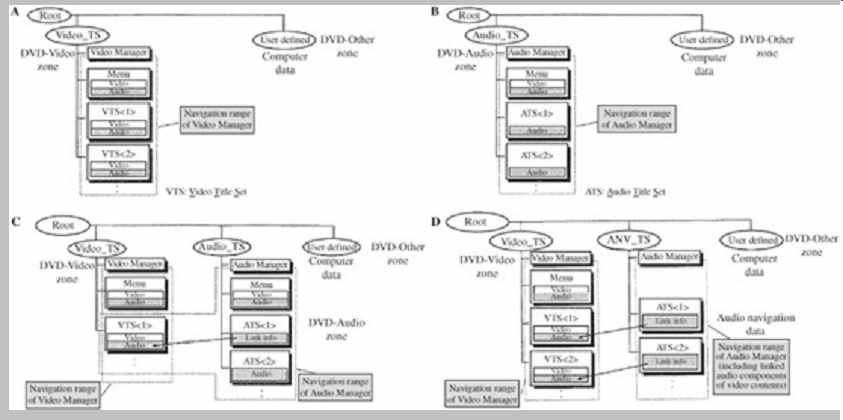
FIG. 11 The same directory and file structure is used for different types
of DVD discs. A. In a "Video" DVD Video disc, the DVD-Video zone
contains the Video Manager and VTS subdirectories that contain data files.
B.
In an "Audio-Only" DVD-Audio disc, the DVD-Audio zone contains the Audio Manager and ATS subdirectories. C. In an "AV" DVD-Audio disc, the Audio Manager can control a subset of the DVD-Video data. D. In a "VAN" DVD-Video disc, Link Info allows a DVD-Audio player to play audio components of video contents.
DVD-Video Video Coding
The task of storing a feature film on an optical disc is far from trivial. A CD disc is woefully inadequate for high quality video storage. For example, if a movie was coded at a video bit rate of 166 Mbps, a CD would hold only about 40 seconds of this uncompressed video and would have to spin at a rate of 58,850 rpm, or 118 times faster than its normal speed. To accomplish its task, a DVD-Video disc takes advantage of the inherently higher capacity and output bit rate of DVD, and more importantly employs data reduction techniques. Although a DVD-Video data layer can hold seven times the data of a CD (4.7 Gbytes) it is insufficient to store a feature film; at a bit rate of 166 Mbps, a layer would hold less than 5 minutes of video. To overcome this, the DVD-Video standard uses the MPEG-2 data compression algorithm to encode its video program.
The algorithm used for DVD-Video is based on the MPEG 2 Main Profile at Main Level protocol, also known as MP@ML. MP@ML is an intermediate level, and below the High Level sometimes used for digital television (DTV).
However, MP@ML yields a high-quality picture that equals that of the professional CCIR-601 (or D-1) standard operating at a rate of 270 Mbps. Even if it could be recorded to a DVD-Video disc without compression (it can't), this CCIR-601 video bit-stream would fill a single sided, single-layer DVD disc in 140 seconds. To instead store over 2 hours of an audio/video program would imply an overall reduction of about 60:1. However, several pre-filtering operations reduce the burden of algorithmic compression.
An NTSC CCIR-601 signal assumes a sampling rate of 858 samples per scan line, 525 lines per frame (yielding a 858-by-525 display) and 30 frames per second; however, many of these samples are off-screen in blanking intervals.
Thus, DVD-Video reduces the number of pixels to a 720 by-480-pixel display. The video bit rate is further decreased by decreasing the word length (for example, from 10 bits per sample to 8 bits per sample). Furthermore, rather than code RGB components, a YCrCb representation can be used more efficiently. For example, both the vertical and horizontal resolution of the chrominance information can be halved; the video program is stored as 4:2:0 component video instead of 4:4:2. These steps reduce the bit rate by 54%.
Additional efficiency can be realized when coding movies. Movies are filmed at 24 frames per second, whereas DVD-Video operates at 30 frames per second; this means that after conversion, 6 out of every 30 video frames are repeated, and this need not be separately coded. Overall, this type of prefiltering on the input signal may decrease the bit rate by 63% (for movie sources).
Although the bit rate may be "only" 100 Mbps, it still requires algorithmic compression. For example, to place a 133-minute movie on a single-sided, single-layer disc, an average compression ratio of 21:1 is still needed.
The MPEG-2 video compression algorithm uses psychovisual models to analyze the video signal to determine how a human viewer will perceive it. Image data that is deemed redundant, not perceived, or marginally perceived, is not coded. This analysis is carried out for both individual video frames and series of frames. Over time, as much as 95% of the video data can be omitted without significant degradation of the picture. Video compression is discussed further in Section 16.
An important aspect of MPEG-2 coding is its variable bit rate (MPEG-1 uses a fixed bit rate). Because some pictures are more difficult to code than others, MPEG-2 allows for a variable bit rate. The bit rate needed to code motion pictures can vary greatly from scene to scene. For example, a scene with a "talking head" surrounded by a static background would require a relatively low bit rate. A fast action scene with a changing complex picture would require a higher bit rate. MPEG-2 encoders output a changing bit rate that reflects the changing degree of picture complexity and coding difficulty; in this way, bits are not wasted on low complexity frames, and artifacts are avoided in high complexity frames. In some encoders, video content may be coded in three passes, to optimize coding efficiency.
The MPEG-2 algorithm is specifically engineered so that improvements can be made in the encoding algorithm while retaining complete compatibility with existing decoders. Thus, the look of video software titles can improve, and the improvement will be seen on current and future players. The picture quality of a particular DVD Video title is also influenced by the expertise used in the picture encoding. An overview of the DVD-Video properties is shown in Table 2.
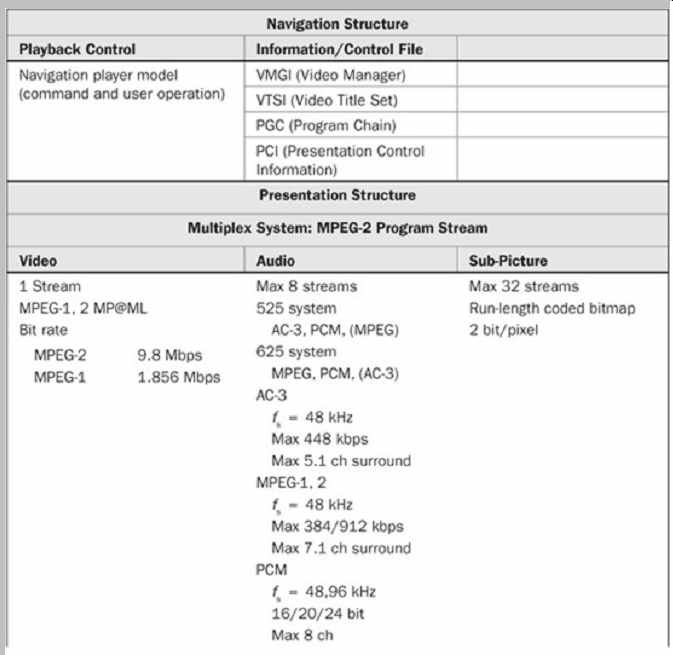
Table 2 Summary of the principal characteristics of the DVD-Video format.
DVD-Video Audio Coding
The audio portion of the DVD-Video standard accommodates both multichannel and stereo soundtracks.
DVD-Video titles can accommodate up to eight independent audio bitstreams. These audio bitstreams can be 1 to 8 channels of PCM, 1 to 6 channels of 5.1-channel (five main channels plus a low-frequency effects channel) of Dolby Digital, or 1 to 8 channels (5.1 or 7.1) of MPEG-2 audio. An NTSC title must include at least one Dolby Digital or PCM audio track. A PAL title must contain at least one Dolby Digital, PCM, or MPEG-2 audio track. A disc can also optionally employ DTS, SDDS, or other audio coding.
Neither MP3 or AAC coding is allowed in the DVD-Video or DVD-Audio zone; however, these codings may be used in areas outside the zones. Dolby Digital is the standard coding used for multichannel soundtracks in the United States and Canada (Region 1) and other regions as well.
Typically, Dolby Digital soundtracks are either stereo or 5.1-channel. For strictly commercial reasons, NTSC players generally play only NTSC discs, but many PAL players can play both NTSC and PAL discs. In either case, the corresponding display (NTSC or PAL) must be connected. Most computers can play both NTSC and PAL discs.
As used with DVD-Video, Dolby Digital (AC-3) codes 1 to 5 main discrete channels plus a discrete low-frequency effects (LFE) channel. A rear center channel can be added using Dolby Digital Surround EX which uses phase matrix encoding. The Dolby Digital sampling frequency is 48 kHz (the norm in digital video applications), the nominal output bit rate is 384 kbps, and the maximum bit rate is 448 kbps. Dolby Digital accommodates resolution of up to 24 bits.
Dolby Digital decoders must also be able to down-mix 5.1 channel soundtracks to stereo PCM. The center and surround channels are matrixed with the main stereo channels in the Dolby Surround format (that can be decoded by Dolby Pro Logic decoders). The LFE channel is not included in the down-mix (for that reason, surround mixes should have bass content that takes full advantage of the low-frequency response of the main channels). An alternative to downmixing in the player is to simply create a new stereo mix and place that on the disc.
In the DVD-Video format, DTS can be optionally used to code 1 to 6 discrete main channels of audio data plus a discrete LFE channel. A rear center channel can be added discretely or by matrixing. The DTS sampling frequency is 48 kHz, and resolution is up to 24 bits. Typical bit rates for a 5.1-channel program are 768 kbps or 1536 kbps (the maximum rate). MPEG-1 stereo audio (Layer II ) is sampled at 48 kHz with a maximum resolution of 20 bits and a maximum bit rate of 384 kbps. MPEG-2 multichannel audio (BC matrix mode) codes up to 7.1 channels. It is also coded at 48 kHz with a maximum resolution of 20 bits and a maximum bit rate of 912 kbps. The AAC codec is not supported. Audio codecs such as Dolby Digital, DTS, MPEG-1, and MPEG-2 are discussed in more detail in Section 11.
For compatibility, DVD-Video movies also carry a redundant PCM digital stereo soundtrack. These PCM audio tracks can employ sampling rates of either 48 kHz or 96 kHz, and word lengths of 16, 20, or 24 bits. The CD sampling frequency of 44.1 kHz is not supported on DVD Video; files must undergo sampling-rate conversion. These PCM audio configurations are supported: 16/48 (up to eight channels), 20/48 (up to six channels), 24/48 (up to five channels), 16/96 (up to four channels), 20/96 (up to three channels), and 24/96 (up to two channels). Because up to eight independent PCM channels are permitted, for example, movies can be released in eight different languages. PCM coding can also employ a dynamic range control (the same provision as in the DVD-Audio specification). This is a disc option and player requirement.
The maximum PCM bit rate allowed on a DVD-Video disc is 6.144 Mbps. Of course, an increase in the audio bit rate decreases the bit rate available to the digital video signal.
To summarize, on a DVD-Video disc, the maximum channel bit rate for DVD is 26.16 Mbps. Following demodulation, this rate is halved to 13.08 Mbps. Following error correction, the maximum bit transfer rate is 11.08 Mbps. The maximum user data bit rate for video, audio, and sub-picture is 10.08 Mbps. The maximum bit rate into the respective buffers is 9.8 Mbps for MPEG-2 video, 1.856 Mbps for MPEG-1 video, 6.144 Mbps for PCM audio (DVD-Video), 9.6 Mbps for MLP/PCM audio (DVD-Audio), and 3.360 Mbps for sub-picture. In addition, these limits apply: 448 kbps for Dolby Digital, 384 kbps for MPEG-1 audio, 912 kbps for MPEG-2 audio, 1536 kbps for DTS, and 1280 kbps for SDDS. From these bit rates, playing times can be calculated; for example, a DVD-9 disc would hold 42 hours and 22 minutes of 5.1-channel Dolby Digital data. Similarly, disc authors can calculate bit budgets, to ensure that contents can fit on a particular disc format.
FIG. 12 shows an example of how the bit rates of various contents are accommodated on a DVD-Video disc. In this example, the average video bit rate is 3.5 Mbps, there are three audio soundtracks each at 0.384 Mbps, and four subtitle streams each at 0.01 Mbps. This yields a total bit rate of 4.692 Mbps, which is within the DVD-Video specification. At this average bit rate, one 4.7 Gbyte layer would hold a 133-minute program comprising 4.68 Gbytes. This capacity can accommodate over 90% of all feature films; longer titles can use dual-layer discs. A 4.7-Gbyte disc might hold 133 minutes of program, an 8.5 Gbyte disc might hold 241 minutes, a 9.4-Gbyte disc might hold 266 minutes, and a 17-Gbyte disc might hold 482 minutes. These timings are only representative examples; different combinations of content streams and their bit rates would yield different durations. During authoring, data reduction is applied so that content fits available disc capacity, within the constraints of sound and picture quality.
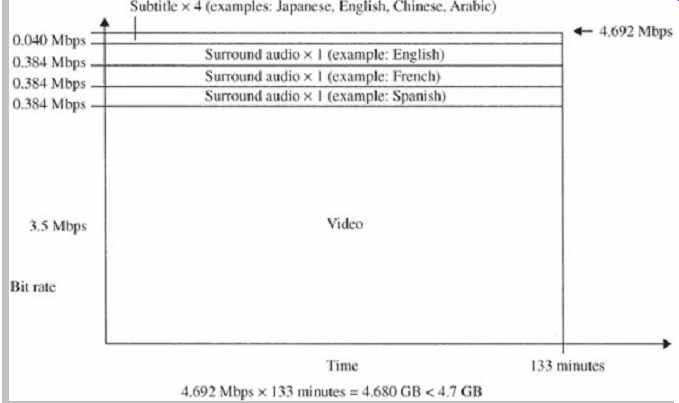
FIG. 12 An example of how a video program, three audio programs, and four
subtitle streams can be placed on a DVD-Video disc, while maintaining an overall
capacity requirement of less than 4.7 Gbytes.
DVD-Video Playback Features
A DVD-Video player is connected to a home theater system and is used to play motion pictures and other video programs from DVD-Video and VAN discs (see below), as well as the video contents on a DVD-Audio AV "Audio with Video" disc and other compatible audio portions such as Dolby Digital tracks. In addition, a DVD-Video player can play audio CDs (not all players can play CD-R discs).
Universal DVD players can play both DVD-Audio and DVD-Video discs. DVD-Video discs cannot be played in CD players. Most DVD-Video players provide a component video output (a professional video standard that avoids the carrier frequencies used in composite video signals) as well as a HDMI output. The 8-bit video signal is generally reproduced with D/A converters with 10-bit resolution. The DVD-Video standard provides a parental lockout; movies can be coded to play different versions, skipping potentially offensive scenes or using alternate scenes and dialogue tracks. A block diagram of the principal elements and signal flow in a DVD-Video player is shown in FIG. 13.
Hybrid DVD-Video discs may contain a movie that is playable in a dedicated DVD-Video player and a DVD ROM-enabled PC; in addition, the ROM drive may be used to access disc contents such as the movie's screenplay, interactive games, screen savers, and hyperlinks to Web sites. The DVD-Video specification (Part 5) also describes a hybrid video-audio disc. Because it contains "video audio navigation" information, it is sometimes known as a VAN disc. VAN discs are video discs but they contain audio information that can be played on DVD-Audio players. The content provider selects which portions of the audio tracks can be played on DVD-Audio players.
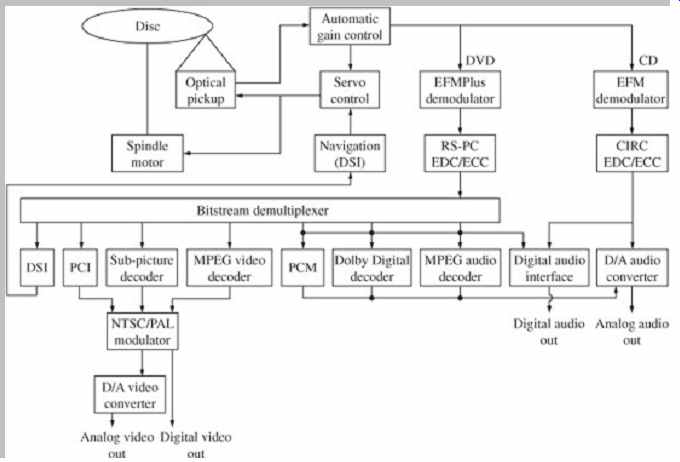
FIG. 13 A DVD-Video player reads data from a disc, distinguishes between
CD and DVD data, and directs data types to specific decoding circuits for processing
and signal output.
DVD-Video supports both normal (4:3) and widescreen (16:9) aspect ratios and an automatic pan-and-scan feature. To perform pan-and-scan, the player must use data specially inserted in the bitstream to display portions of a 16:9 picture on a 4:3 screen. In 16:9 mode, the player ignores the pan-and-scan data and instead produces a wide-screen image. Alternatively, a 16:9 image can be letterboxed on a 4:3 screen with black stripes at the top and bottom of the screen. Other features include section division, forward and reverse scanning, up to nine camera angles and interactive story lines. These features are disc options, and implementation is left to the content provider.
Digital audio data stored at a 96 kHz sampling rate is not output through a player's conventional digital audio outputs; it is downsampled to 48 kHz.
From an audio standpoint, the most significant feature of DVD-Video (and DVD-Audio) is multichannel playback of surround sound. Although discs can be coded with different audio channel outputs, the de facto standard is 5.1-channel playback. FIG. 14 shows a loudspeaker configuration recommended for reproducing Dolby Digital surround sound. The front left/right speakers are placed at ±30° and the surround speakers at ±110° from the center. Optimal placement of the LFE channel speaker depends on room acoustics. One or two additional rear channel speakers are sometimes added.
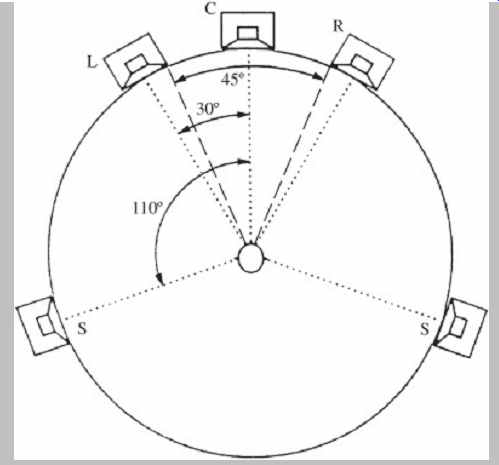
FIG. 14 This loudspeaker configuration, taken from the ITU-R BS.775-2
recommendation, is often used for playback of multichannel audio from DVD,
HDTV, and other surround sources. Other configurations are also used.
Optimal placement of the LFE subwoofer depends on room acoustics. In some cases, additional rear speakers are added.
The DVD-Video format supports up to 32 channels of sub-picture information. Sub-pictures are graphic files that are bitmapped or overlayed onto the picture. Sub-pictures are generally used for captions, subtitles, or other text. Sub pictures can be scrolled and faded and can change in every video field. The color palette comprises 16 colors and contrast values; four colors and four contrast values can be displayed in one channel at a time. Sub-picture data is a run-length coded bitmap with 2 bits/pixel, each at a bit rate of 10 kbps. Sub-picture information can be accessed by timecode or user button depressions to produce graphics and simple animation.
Discs and players contain regional coding flags so players will only play properly coded discs. For example, a Region 2 ( Europe and Japan) player will not play discs intended for the North American (Region 1) market. This allows movie studios to control release of titles to different global markets. Regional codes on discs are optional; support is mandatory on players. Discs can be made with multiple codes, or no codes; discs with no codes will play on all players, regardless of country. There are six geographic regions: (1) Canada and the United States and its territories; (2) Japan, Western Europe, South Africa, Turkey, and the Middle East; (3) South Korea, Southeast and East Asia including Hong Kong; (4) Australia, New Zealand, Pacific Islands, Central America, Mexico, South America, and the Caribbean; (5) Russia, Indian Subcontinent, Africa, North Korea, and Mongolia; (6) People's Republic of China and Tibet. Region 7 is reserved. Region 8 coding is used for nontheatrical venues such as airplanes, cruise ships, hotels, and so on.
DVD-Video Authoring
A DVD-Video disc can hold video content, multiple soundtracks, subtitles, bonus features, and Web links, and allow elaborate navigation features. A DVD-Audio disc can hold stereo and multichannel music as well as videos, still photographs, graphics, animation, lyrics, and other features. In addition, most DVD-Audio discs hold a Dolby Digital mix for playback in DVD-Video players. A simple DVD title can be authored on a personal computer. A complex title can entail use of diverse professional authoring tools; in many cases, specialists in audio, video, graphic design, and interactivity handle different aspects of the workflow. Whether simple or complex, all title production is computer-based. First, the contents and functionality of the title are determined, along with navigational use of the contents. Also, a bit budget is navigational use of the contents. Also, a bit budget is determined to ensure that all contents will fit on a disc's layers, and peak output bit rates are checked. In most cases, content is already prepared before authoring begins. However, authoring steps must ensure that content adheres to the DVD standards. Audio and video content is supplied and coding is applied when necessary. Artwork, transition sequences, and still or animated menu graphics are created. Web-based multimedia programs are created. Following postproduction, all video and audio content is processed with appropriate coding such as Dolby Digital, DTS, or MPEG-2.
In DVD-Video authoring, program chains for parental lockout, camera angles, alternate endings, regional coding information, and supplemental information is prepared. In some cases, movie soundtracks need to be re-conformed to the video being used, or remixed to a surround format.
Also in DVD-Video authoring, it is essential that time synchronization of video and audio content is assured on the final disc. In DVD-Audio authoring, MLP coding and downmixing data is applied as necessary. Menu buttons are linked to content or other menus. Elementary streams are created and checked. The simulation is checked for any violations to the DVD specification and thoroughly tested and debugged. The streams are input to an authoring system to create a DVD disc image. The image is complied to a virtual disc format; data is multiplexed into a single composite stream, navigation files are generated, and data is formatted according to Micro UDF Bridge/ISO 9660 format. The image is placed on a hard-disk drive and playback is emulated with a DVD player application. The image is burned to DVD-R or another disc type and tested again. All audio and video elements are reviewed, sound to-picture synchronization is checked, along with disc navigation and functionality. In some cases, the image is played from the DVD-R into the authoring workstation and the emulation is further checked and debugged there. A finished, encrypted version is written to DLT tape along with DDP data. A manufacturing plant produces test discs that are checked for functionality and player compatibility. After approval, finished discs can be replicated. A list of the principal steps in DVD-Video authoring (which is similar to DVD-Audio authoring) is given in Table 3.
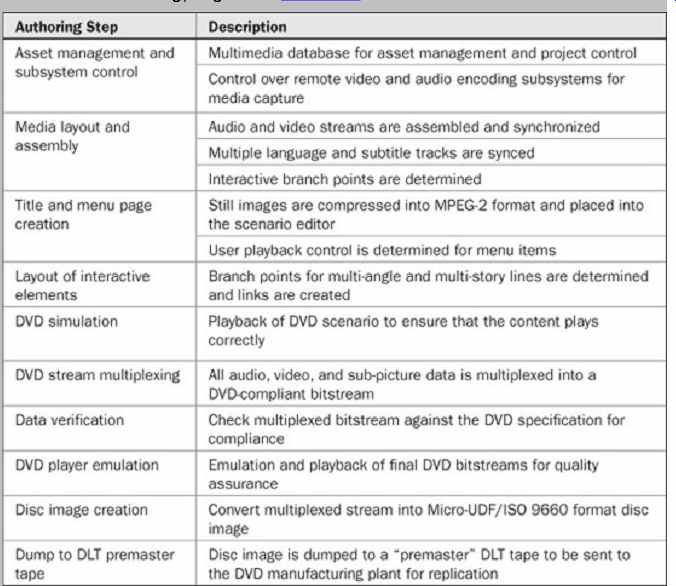
Table 3 Principal steps in the authoring of a DVD-Video disc.